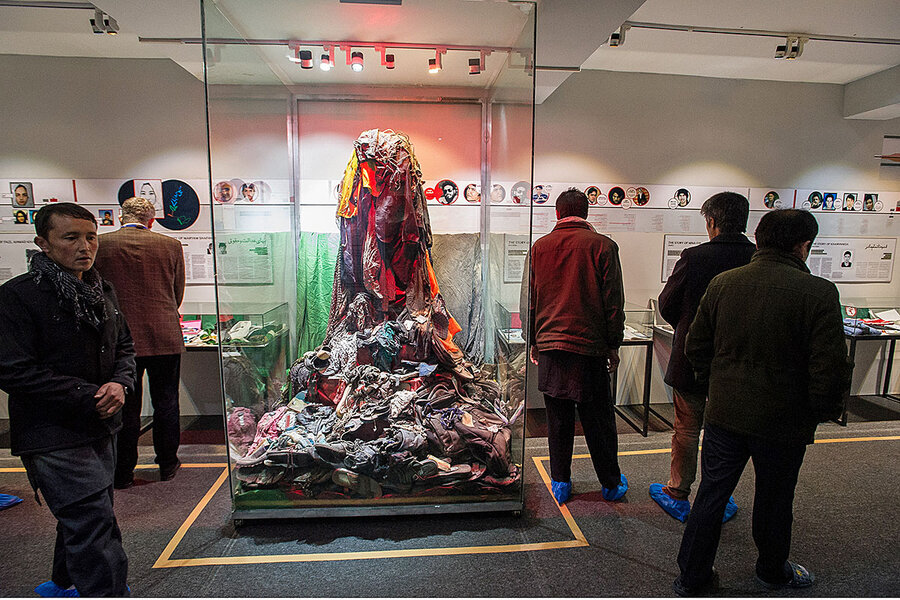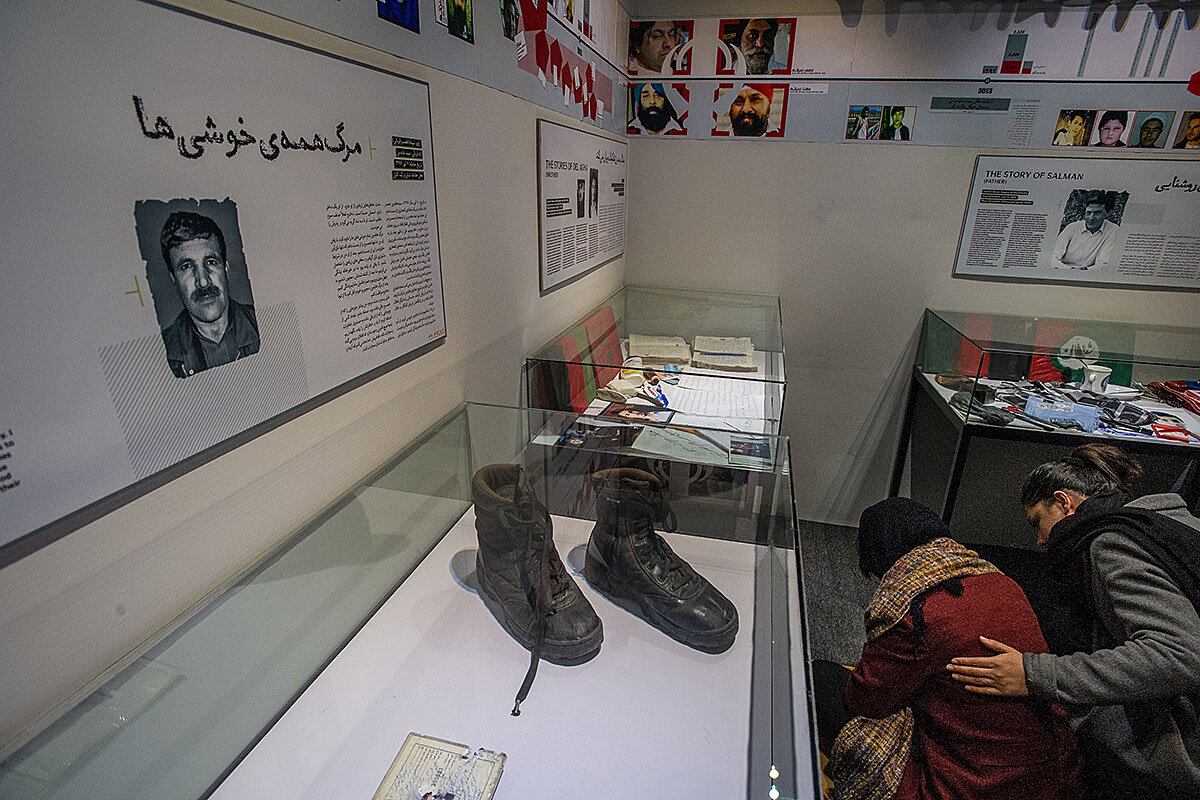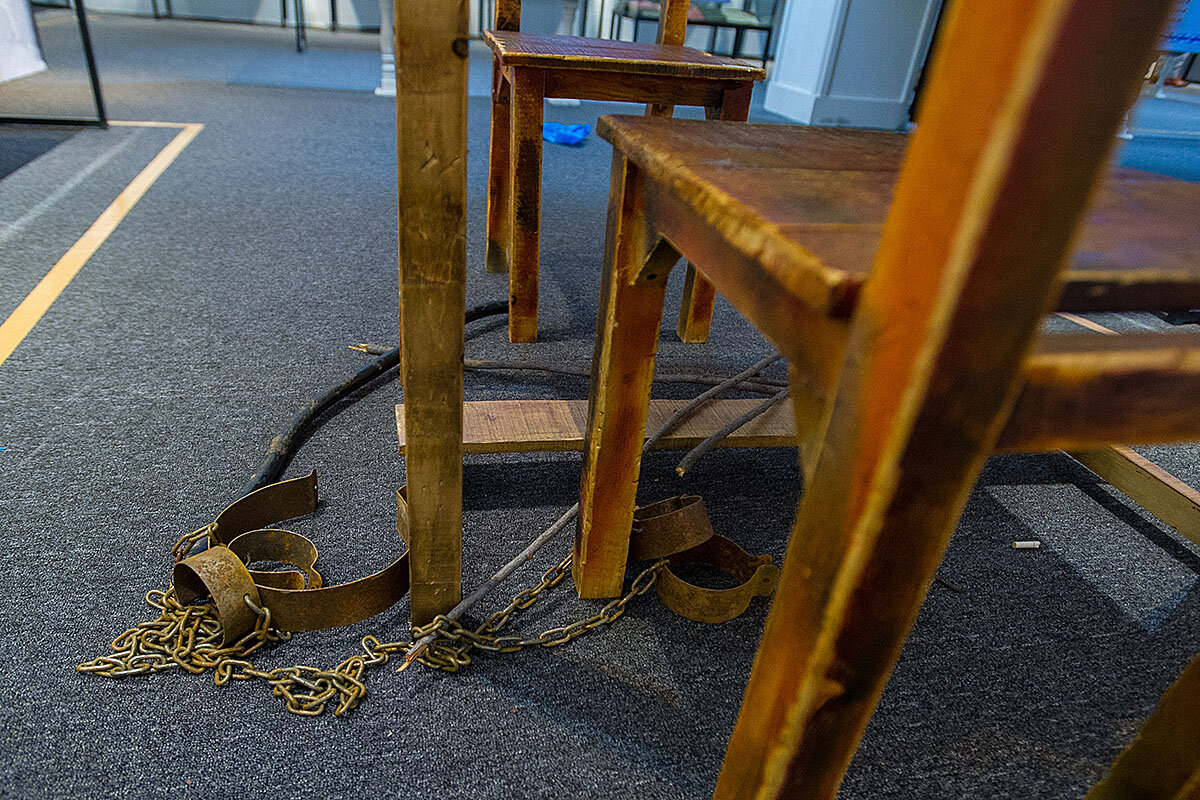Artifacts and tears: Afghans confront emotional costs of war
Loading...
| KABUL, Afghanistan
A veteran of Afghanistan’s endless wars, Kabal Shah can only wipe away his tears when he frees his hand from one of his crutches, holding the metal support steady with the stump of his amputated leg.
Wearing a thick beard on his grizzled face and a wool shawl over his shoulder to ward off the late winter cold, Mr. Shah is part of the emotional outpouring at the opening of the Afghanistan Center for Memory and Dialogue – the first repository of four decades of victims’ memories to be systematically collected in the country.
The center is a project of the Afghan Human Rights and Democracy Organization (AHRDO), which since 2009 has sought to foster interethnic and intercommunity peace through cultural and artistic initiatives such as traveling theater productions and memory workshops.
Why We Wrote This
Our reporter attended the emotional opening in Kabul of a center dedicated to preserving the memory of Afghanistan’s many war dead. What he heard was a yearning for peace.
Mr. Shah has propped himself for mourning beside a glass case full of the mementos of his youngest brother, Adel Shah, an uneducated hairdresser killed by chance by a Taliban suicide bomb near the U.S. Embassy in Kabul in April 2016.
It is the memory of his brother’s shoes that triggers the tears, says Mr. Shah, amid the collected remembrances of so many civilian casualties in a nation now defined by more than a generation of war. The ambulance driver who brought the body asked Mr. Shah if he could have his brother’s new shoes, and out of gratitude, Mr. Shah acquiesced.
“Thousands of people are like my brother, who are victimized,” says Mr. Shah. “When I saw the photos here, I thought I should share my deep condolences with all these people. After this, I really need peace.”
The cumulative cost of Afghanistan’s wars borne by Mr. Shah’s family is typical of that paid by their fellow citizens. Two other family members were killed in a mine explosion, and a rocket landed on the family house in the early 1990s, killing nine more and taking Mr. Shah’s leg. In total, the family counts 15 victims.
“This is shameful for jihadi leaders, and for those officials who are still involved in the killing process,” says Mr. Shah. “All those people who have done such crimes … one day they should come to justice.”
The focus on war victims could not be more timely or relevant, as the United States conducts the first direct peace talks with the Islamist Taliban, which since 2001 have embroiled the American military in the longest war of its history.
Yet while U.S. officials and Taliban chiefs make positive sounds about peace, the Afghan government has yet to be officially included in the process, and the scale of bloodshed for decades here – amply demonstrated by the exhibits at this new center – attests to the challenges of reconciliation that lie ahead.
Starkly prominent amid the names and faces of victims, and the grim testimonies that crowd the walls and display cases, is a six-foot-tall mound of blood-stained, shredded clothes collected at the sites of different suicide bombings.
Piled among them are also shoes, torn from their owners, and other everyday items: broken eyeglasses, mobile phones pierced by shrapnel, crushed watches – even a digital watch stuck at 9:44 a.m., the seconds on the readout still blinking.
Preserving memory
The center counts more than 2 million Afghan civilians killed from 1978 to 2001, and some 70,000 more dead and injured since 2009. It adds that civilian casualties “remained undocumented” from 2001 to 2009 – the first years after the U.S. toppling of the Taliban and start of the current insurgency.
Explanations on the wall note how the center aims to avoid a “double catastrophe,” in which the first is the initial loss of life, and the second is “erasing” those deaths from Afghanistan’s “collective memory.”
The team so far has collected more than 4,000 personal objects and stories during eight years of work to “salvage, protect and share memories” of war victims and “provide a safe space for truth-telling.” The emotive weight of the center on visitors – despite being modestly situated in the basement of a rented house – is heavy with significance.
“It’s a healing process for both sides,” says Sima Samar, chair of the Afghan Independent Human Rights Commission and a former minister of women’s affairs, who officially opened the center last month.
The center serves as “a reminder of the lack of justice for these people, and that the lack of accountability for the crimes of the past will fuel impunity, which we still see with the continuation of the conflict and the killing,” says Ms. Samar. The center, she adds, also aims to “remind the perpetrators and the criminals that they have done something wrong, and to encourage them to come and confess, and to ask for an apology.”
Such collective memories should inform future generations, Ms. Samar says, noting that two of her four family members who perished in wars are not yet listed. And she says she hopes the Afghan government and Western donors will support the center so it can expand beyond the basement into a dedicated museum space.
“If we don’t try to heal the wounds of the people, we will not be able to stop the cycle of violence,” says Ms. Samar. “We all need peace, but peace without respect for human rights and justice will not be a sustainable peace.”
Sitting alone in a corner of one room, clearly distraught, Zahra Hussaini is consoled by a colleague who puts an arm around her back. As a program officer with AHRDO, she helped curate the center and gather its memories.
“None of my family are here, but I imagine all these people who are in these photos are my family,” says Ms. Hussaini.
History as motivator
Each regime that ruled modern Afghanistan “did their dark thing to the nation,” she says. “So as you survey this room, this is the least number [of victims]. If we count every family in Afghanistan, they gave victims directly, or their colleagues or extended family did.”
Relatives of victims were reluctant to share their stories at first, she says, but opened up when the historical import was explained.
“If we spoke to them about the future, about the new generation, finally they became happy … because they want to show all the world what is happening in Afghanistan,” says Ms. Hussaini.
“In this exhibit we reflect that all of us sacrificed, not only one person,” she says. “Here are people from all Afghanistan, from every [ethnic] nation, from every tribe.”
Salim Rajabi, the senior program manager for AHRDO, says the work to collect personal objects and testimonies about civilians who were killed began in 2011. The original idea was to keep them in wooden ammunition boxes, he says, to transform those tools of war into the keepers of the memories.
Gathering the ammunition boxes proved impractical, so some families make and paint similar wood and metal boxes themselves, and use games and exercises to give self-confidence and create a form of closure.
“We are trying to change their personal stories into collective stories, to show them that here is a safe place for them to talk, where everyone is respecting each other,” says Mr. Rajabi. The families of victims themselves pushed for the permanent exhibit, so that everyone “would know their pain.”
Four sons
While he speaks, an older Afghan woman from Laghman province, missing many teeth, screams as she gets to the case that immortalizes the memory of her sons – four of whom she lost.
Zia Gul’s sons were lost in different incidents: One was murdered during the war-torn reign of President Najibullah, who ruled with Soviet backing until 1992; one was still a child when a rocket landed on the tiny kiosk where he sold cigarettes during the mujahideen era of the mid-1990s; yet another was a soldier killed by a Taliban rocket while he visited a cucumber patch.
Citing poor memory, Ms. Gul can’t recall the circumstances of her lost fourth son.
“The only thing keeping me alive is my faith and my trust in God’s justice,” she says, when sharing her memory for the center. She wanted to tell her story so no one would forget that “war cannot be uglier than losing four young sons and at the end a mother having to live and suffer on her own.”
Ms. Gul pulls away from the glass case and is beside herself.
“My four sons have been killed,” she cries. “I am alone now.”









